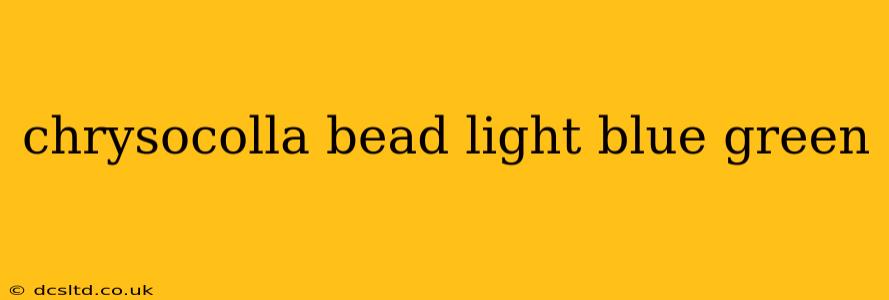Chrysocolla, with its captivating light blue-green hues, has become a beloved gemstone for jewelry makers and collectors alike. Its soothing colors and purported metaphysical properties contribute to its rising popularity. This guide dives deep into the world of chrysocolla beads, exploring their unique characteristics, variations in color and quality, and how best to care for these beautiful gems.
What are Chrysocolla Beads Made Of?
Chrysocolla is a hydrous copper phyllosilicate mineral, meaning it contains copper, silicon, oxygen, and water molecules. This unique chemical composition is responsible for its vibrant, often variegated, colors. The exact shade can vary significantly depending on the presence of other minerals and impurities within the formation. This also influences the hardness and durability, making some chrysocolla beads more fragile than others.
What Colors Can Chrysocolla Beads Be?
While often described as light blue-green, chrysocolla beads exhibit a wide spectrum of colors. You'll find shades ranging from a pale, almost turquoise blue to a deeper, richer teal green. Some stones display a mottled appearance with swirling patterns of light and dark shades. The presence of other minerals, like malachite or azurite, can introduce flecks of green, blue, and even black into the mix. This variability is part of what makes each chrysocolla bead unique and visually striking.
Are Chrysocolla Beads Durable?
Chrysocolla's hardness on the Mohs scale typically ranges from 2 to 4, making it a relatively soft gemstone. This means it's more susceptible to scratching and damage than harder stones like quartz or topaz. For this reason, chrysocolla beads are generally best suited for earrings, pendants, or other jewelry items that experience less daily wear and tear. Avoid exposing your chrysocolla jewelry to harsh chemicals or abrasive materials.
How Can I Tell if My Chrysocolla Beads are Real?
Determining the authenticity of chrysocolla can be challenging due to its variability and the existence of treated or synthetic versions. Reputable sellers will provide certificates of authenticity, but several factors can help you assess genuine chrysocolla beads:
- Color and Pattern: Look for natural variations in color and pattern. Uniformity can be a sign of a synthetic or heavily treated stone.
- Texture: Real chrysocolla often has a slightly waxy or resinous texture.
- Hardness: While a Mohs hardness test isn't practical for jewelry, a genuine chrysocolla bead should feel relatively soft compared to harder gemstones.
- Luster: Chrysocolla generally has a vitreous or waxy luster.
How Do I Care for My Chrysocolla Beads?
Proper care ensures your chrysocolla beads retain their beauty for years. Here are some essential tips:
- Gentle Cleaning: Use a soft cloth and mild soap and water to clean your beads. Avoid harsh chemicals or ultrasonic cleaners.
- Storage: Store your chrysocolla beads individually in a soft pouch or box to prevent scratching.
- Avoid Exposure: Keep your chrysocolla beads away from extreme temperatures, direct sunlight, and harsh chemicals.
What are the purported metaphysical properties of Chrysocolla Beads?
Many believe chrysocolla possesses calming and healing properties. It's often associated with communication, emotional balance, and spiritual growth. However, it's important to remember that these properties are based on belief and not scientifically proven.
Where can I buy high-quality Chrysocolla beads?
Finding high-quality chrysocolla beads often involves searching reputable gemstone dealers, both online and in physical stores. Look for sellers who provide detailed descriptions, high-quality images, and, ideally, certificates of authenticity.
This comprehensive guide should provide a solid understanding of chrysocolla beads, from their formation to their care. Remember, each bead is unique, making every piece of chrysocolla jewelry a special treasure.
